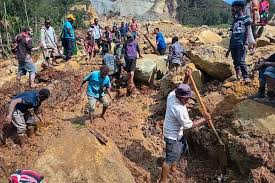Death toll in Papua New Guinea landslide rise, survivors dig with hands and spades
By Jeph Ajobaju, Chief Copy Editor
From an initial 670 casualties, the death toll in the huge landslide in Papua New Guinea (PNG) on May 24 has risen to 2,000 as disclosed by the country’s National Disaster Centre, with survivors recounting the horror of losing so many loved ones in the mountainous nation of 10 million people in the south western Pacific.
The landslide occurred in the mountainous Enga region in northern PNG on Friday and the latest missing figure is a sharp rise from earlier estimates.
Locals have been left reeling after tonnes of rock and mud smashed into their homes as they slept. Rescuers have struggled to reach such a remote part of what is already one of Asia’s poorest nations in the south western pacific, leaving locals with little choice but to dig through the collapsed mountainside with whatever tools they have.
Evit Kambu confirmed she lost more than a dozen family members in the disaster.
“I have 18 of my family members buried under the debris and soil that I am standing on and a lot more family members in the village I cannot count,” she told Reuters. “I am the landowner here … but I cannot retrieve the bodies so I am standing here helplessly.”
Miok Michael, a community leader, told CNN that it was likely there were few survivors. “People are gathering and mourning,” he said. “People have been digging since day one but can’t locate bodies as they are covered by huge rocks. Only machines will do.”
Soon after the disaster occurred, the United Nations said as many as 100 may have died. That was later revised up to 670, according to estimates from the Chief of Mission for the International Organization for Migration (IOM) in the country.
But that may now be a major underestimate according to the latest projection from Papua New Guinea’s disaster agency.
“The landslide buried more than 2,000 people alive and caused major destruction to buildings, food gardens and caused major impact on the economic lifeline of the country,” Lusete Laso Mana, Acting Director the National Disaster Centre, said in a letter to the UN.
“The situation remains unstable as the landslip continues to shift slowly, posing ongoing danger to both rescue teams and survivors alike,” he added, saying the main highway to the area had been completely blocked by the landslide.
__________________________________________________________________
Related articles:
Court orders Jacob Zuma, 79, back to jail
Oscar Pistorius released from prison after serving 9 years for killing girlfriend Reeva Steenkamp
Black man released from US prison after spending nearly 50 years for murder he didn’t commit
__________________________________________________________________
The scale of the devastation
Chris Jensen, PNG National Director of World Vision, told CNN that rescue workers “clearly realized the scale of the devastation.”
“This is a landslide of massive proportion. It’s quite astonishing – a whole mountain literally fell on so many households during the middle of the night.”
“We can’t create further problems with land … so we really got to be very careful about the response now,” Jensen said.
Justine McMahon, PNG Country Director for the global humanitarian agency CARE International, said the full death toll “was still unknown, because only a few bodies had been recovered.”
“The authorities have been very effective and very responsive and are working around the clock… but I think given the scale of this disaster and the (numbers of) people affected, there will be resources needed from the wider aid community,” McMahon told CNN.
She added that “a great challenge today had been that the ground is still quite unstable.”
“Given that houses were buried under up to 8 meters of dirt (more than 26 feet), it will be difficult to reach some of the victims,” McMahon said.
Landslide in Enga region
Serhan Aktoprak from the UN agency, International Organization for Migration (IOM), told Reuters that teams on the ground were “trying to rescue whatever they can by using digging sticks, spades, agricultural forks and their hands.”
The landslide hit the remote village of Kaokalam, about 600 kilometers (372 miles) northwest of the capital Port Moresby, at approximately 3 a.m. local time on Friday, leaving a scar of debris that humanitarian workers said was as big as four football pitches.
More than 150 houses in Yambali village were buried in debris, officials said on Sunday. The area continues to pose an “extreme risk,” officials said, as rocks continue to fall and the ground soil is exposed to constant increased pressure.
Papua New Guinea is home to around 10 million people. Its vast mountainous terrain and lack of roads have made it difficult to access the affected area.
Pierre Rognon, an associate professor from the University of Sydney’s School of Civil Engineering, said it’s “particularly challenging” for rescuers to find survivors after a landslide.
“Landslides can bury collapsed structures and people under dozens of meters of geomaterials,” he said.
“To make things worse, they can move structures and trap people over hundreds of meters. No one can predict exactly where potential survivors may be located and where to start looking for them.”
It’s not clear what caused the landslide, but geology professor Alan Collins from the University of Adelaide said it occurred in a region of “considerable rainfall.”
“Although the landslide does not appear to have been directly triggered by an earthquake, frequent earthquakes caused by plates colliding build steep slopes and high mountains that can become very unstable,” Collins explained.
He said rainfall could have altered the minerals making the bedrock, weakening the rock that forms the steep hillsides.
“Vegetation mitigates this as tree roots can stabilise the ground and deforestation can make landslides more prevalent by destroying this biological mesh.”
“We have to look at what caused this,” added Jensen of World Vision.
“There are no reports of earthquakes at this time but we did have quite a lot of rain and a lot of unseasonal weather happening across Papua New Guinea,” Jensen said.
“There is flooding in other provinces and we’ve got a lot of challenges exacerbated by climate change so we’ll do further assessments and analysis to try and figure out what caused this.”











